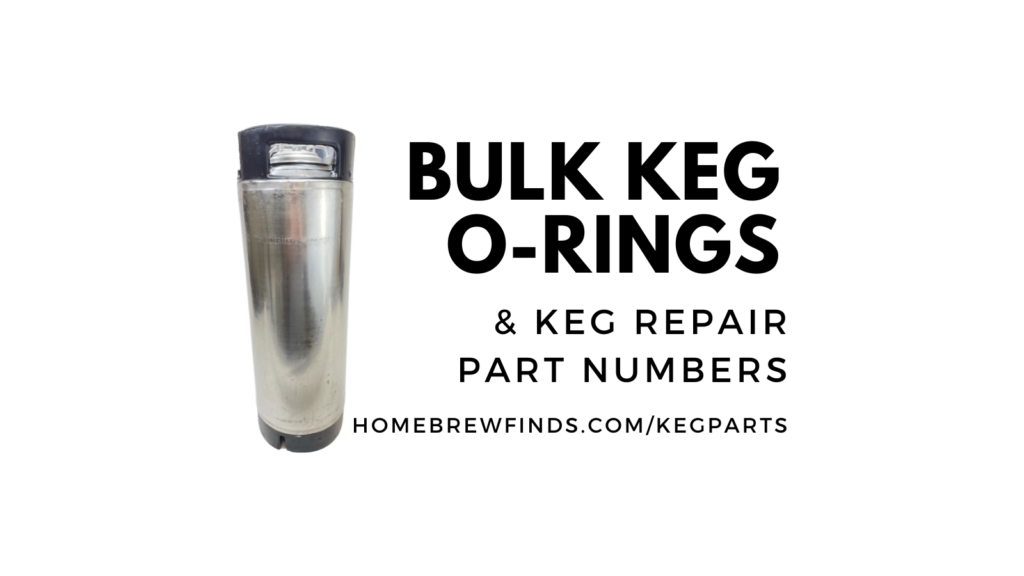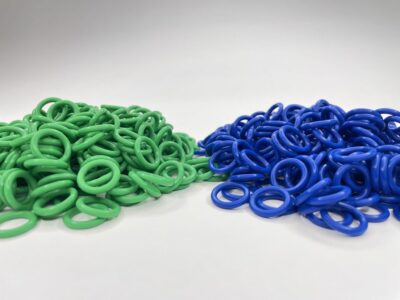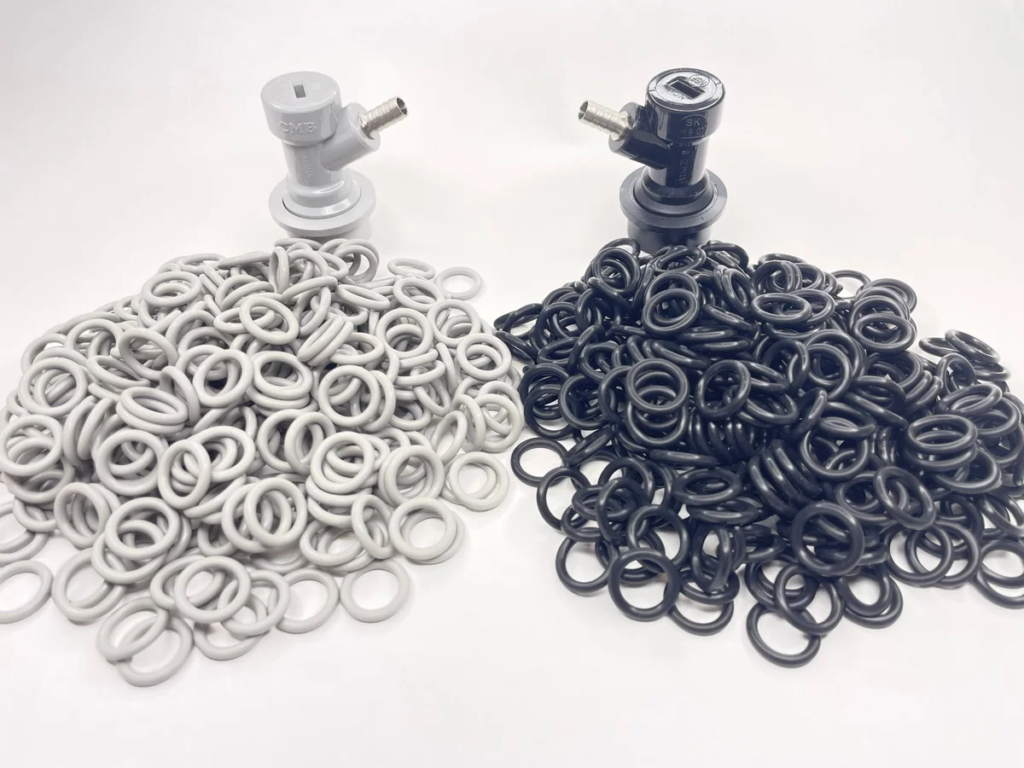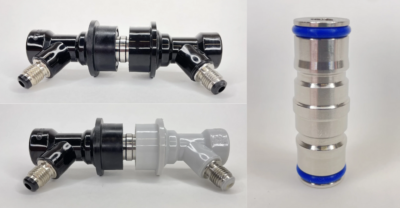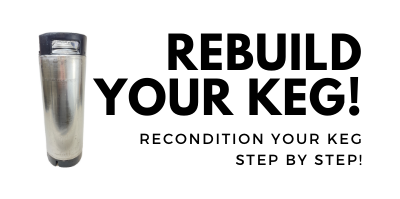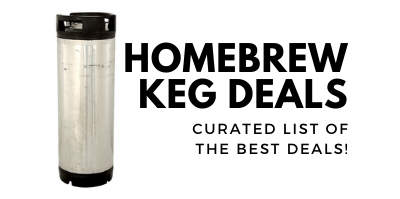
Bulk Keg Orings and Keg Parts Reference
You can save a bunch by buying homebrew keg o-rings in bulk. Here are some part numbers, background and tips on keg gaskets along with part numbers and sources for everything related to your homebrew kegs.
This is a extensive resource post. Here’s what’s covered…
- Replacement Keg O-Rings
- Keg O-Ring Materials Selection – EPDM, Silicone and Buna-N
- Keg Dip Tube O-rings
- Keg Post O-Rings
- Keg Lid O-Rings
- Internal Ball Lock Quick Disconnect O-Rings
- Ball Lock Keg O-Rings vs Pin Lock Keg O-Rings – are they the same?
- Universal Poppet O-Rings
- Universal Poppets – 304 Stainless + Food Grade Silicone & Reliable O-Ring Replacements
- Food Safe Materials for Keg O-Rings?
- Shelf Life and When Should I Replace My Keg O-Rings?
- One-Off and Metric Sized Keg O-Rings
- Other Keg and Kegerator Rebuild & Replacement Parts
- Replacement Lids
- Poppets
- PRV Valves
- Keg Posts
- Post Thread Sizes
- Keg Lid Feet
- Keg QD Replacement Parts
- Replacement Dip Tubes
- Faucet Repair Parts and Resources
- Replacement Keg Handles and Bases
- Keg Quick Disconnects
- Racetrack Style Keg Parts
- Tools for Removing Keg Posts
- Odds and Ends
- Keg Parts Landing Pages
- Keg and Draft Related Reviews
- Rebuild Your Kegs
- DuoTights
- Our Curated List of Keg Deals
Replacement Keg O-Rings
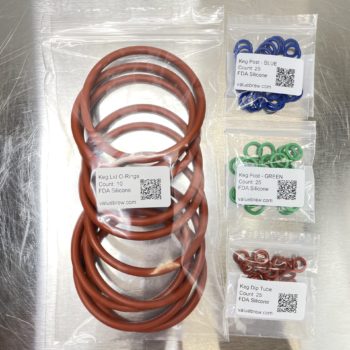 See More About O-Rings in our Keg Rebuild Post – Jump To: Replacing O-Rings
See More About O-Rings in our Keg Rebuild Post – Jump To: Replacing O-Rings
Keg O-Ring Materials Selection – EPDM, Silicone and Buna-N
Food Safe Materials
If you’re using your keg for anything food related (beer=food)… My recommendation is to purchase o-rings made out of material safe for food contact.
Generally speaking, food safe o-rings may cost a little more, but, we’re, generally, only talking a few cents per o-ring. It’s worth it.
Food grade options are oddly hard to find. One notable supplier features all food safe o-ring offerings.
More on this subject later in the post
Material Selection
I would venture a guess that Silicone and Buna-N are the two most commonly used compounds for keg o-rings. EPDM, which has been the choice of professionals for a long time, is probably a distant third, but coming on strong since they’ve become more accessible to homebrewers.
EPDM is a favorite of many pro brewers for certain applications. It has some real advantages over silicone. One of the big ones is a much lower permeability. That means they’re less porous andmore resistant to absorbing off-smells and off-flavors.
Until now, these have not been available to homebrewers, or at least easily available. Valuebrew now offers these in bulk quantities at a reasonable price, albeit more expensive than silicone and Buna-N.
EPDM vs Silicone vs Buna-N is actually a pretty big question. I have a resource post dedicated to this question. See: Keg O-Ring Materials Selection – EPDM, Silicone and Buna-N. I recommend you take a look at that but here are my quick picks…
Quick Picks:
- Keg Lid O-Rings – Silicone, especially if the keg is misshapen or dinged up. EPDM if you’re aging a beer in a keg.
- Keg Dip Tube O-Rings – Silicone, unless the keg is pristine and you’re confident that it uses standard sizing. If that’s the case EPDM
- Keg Post O-Rings – Silicone – hard to pass up… Custom Color Silicone O-rings
Keg Dip Tube O-rings
As noted above, I recommend replacing your gas post o-rings frequently. My suggestion is every other batch.
Dip tube o-rings sizing: Generally speaking keg o-rings are standard sizes. There are some rare outliers out there, dip tube o-rings seem to be the most likely to be non-standard. In my opinion, best practice is to hang on to your originals so you can compare with replacements. In the event that your keg has non-standard dip tube o-rings, you should contact the manufacturer for replacements. Fortunately this is a rare issue, standard sizes fit the vast majority of kegs.
- Food Safe, Silicone – Keg Dip Tube O-Rings – Food Safe Silicone – *see note on food safety
- Food Save, FDA Rated EPDM – Keg Dip Tube O-Rings – FDA Rated EPDM – *see note on food safety
A Note on Gas O-rings I am quick to replace gas o-rings. A leak at the post is particularly difficult to test for. I have lost multiple tanks of CO2 before learning this lesson. In bulk, these are cheap, replace them liberally. See my section on keg o-ring life below, but my suggestion is to change these liberally.
Other Options – correct size, but not food grade
- Buna-N: 109 Buna-N O-Ring, 70A Durometer, Black, 5/16″ ID, 1/2″ OD, 3/32″ Width (Pack of 100)
- Silicone: 109 Silicone O-Ring, 70A Durometer, Red, 5/16″ ID, 1/2″ OD, 3/32″ Width (Pack of 100)
Keg Post O-Rings
As noted above, I recommend replacing your gas post o-rings frequently. My suggestion is every other batch.
- Food Safe, Silicone – Keg Post O-Rings for Ball Lock Kegs – Food Safe Silicone – *see note on food safety
- Food Save, FDA Rated EPDM – Keg Post O-Rings – FDA Rated EPDM – *see note on food safety
Custom Color Post Options:
Designed to help you quickly and easily identify gas and liquid posts.
Available in two color schemes blue & green (blue for beer, green for gas) and gray & black (matches QD colors). Gray and black are standard colors on ball lock, pin lock (usually the bottom portion of the QD) and even recently released Kegland QDs (center portion). All options are FDA rated silicone.
- Green & Blue Post O-Rings at Valuebrew
- Gray & Black Post O-Rings at Valuebrew
- Custom Color O-rings at Valuebrew
- BLUE Food Safe, Silicone – Keg Post O-Rings – Food Safe Silicone – in BLUE – identical in function but available in custom blue. The idea is to color code your keg posts for quick identification. Blue = Beer.
- GREEN Food Safe, Silicone – Keg Post O-Rings – Food Safe Silicone – in GREEN – identical in function but available in custom green. The idea is to color code your keg posts for quick identification. Green = Gas.
Compare: William’s Brewing has some alternate color options. However those are much more expensive on a per o-ring basis and, at least as of this posting, product descriptions give no indication at all what these are made from.
Other Options – correct size, but not food grade
- Buna-N: 111 Buna-N O-Ring, 70A Durometer, Black, 7/16″ ID, 5/8″ OD, 3/32″ Width (Pack of 100)
- Silicone: 111 Silicone O-Ring, 70A Durometer, Red, 7/16″ ID, 5/8″ OD, 3/32″ Width (Pack of 100)
Compare: William’s Brewing has some alternate color options. However those are much more expensive on a per o-ring basis and, at least as of this posting, product descriptions give no indication at all what these are made from.
Keg Lid O-Rings
- Food Safe, Silicone – Keg Lid O-Rings – Food Safe Silicone – *see note on food safety
- Food Save, FDA Rated EPDM – Keg Lid O-Rings – FDA Rated EPDM – *see note on food safety
- Food Safe, Buna-N – Keg Lid O-Rings – Food Safe Buna-N – *see note on food safety
Other Options – correct size, but not food grade
- Buna-N: 417 Buna-N O-Ring, 70A Durometer, Round, Black, 3-1/2″ ID, 4″ OD, 1/4″ Width (Pack of 10)
- Silicone: 417 O-Ring, Silicone, 70A Durometer, 3-1/2″ ID, 4″ OD, 1/4″ Width, Red (Pack of 5)
- Silicone: 417 Silicone O-Ring, 70A Durometer, Red (Pack of 5)
- Silicone: 5PCS/LOT Brand new Silicone Cornelius Type Keg Seal Replacement Kit o-ring rubber
- Soft Silicone: Brewery Gaskets 2-Pack O-Ring Gasket for Cornelius Home Brew Keg, Soft Silicone
Leaky Lid O-rings
William’s Brewing Oversize Keg Lid O-ring is slightly over-sized and made from a softer rubber. It’s designed to help you achieve an airtight seal for leaky ball and pin lock keg lids.
Internal Ball Lock Quick Disconnect O-Rings
Dash 013 o-rings are not OEM internal ball lock QD gaskets, but in my experience they have fit in all the QDs that I’ve tried. Your experience may vary. Check out my post on the subject including some photos – See: CMBecker Ball Lock QDs + Replacement O-Rings
- Food Safe, Silicone – Internal QD Replacement O-Rings – Food Safe Silicone – *see note on food safety
- Food Safe, FDA Rated EPDM – Internal QD Replacement O-Rings – FDA Rated EPDM – *see note on food safety
Other Options – correct size, but not food grade
If you’re looking for CM Becker OEM replacement parts, check out Keg Connection. They have a nice diagram that shows all the parts and pieces – (gaskets, spring, stem and caps) for both ball lock and pin lock QDs. See: Disconnect Parts List at Keg Connection
Ball Lock Keg O-Rings vs Pin Lock Keg O-Rings – are they the same?
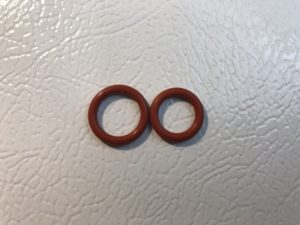 Pin Lock Post O-Ring on Left, Ball Lock Post O-Ring on Right
Pin Lock Post O-Ring on Left, Ball Lock Post O-Ring on Right
Standard pin locks and ball locks use identical dip tube o-rings and lid o-rings
Post o-rings are a different story. Standard pin lock keg post o-rings are slightly larger than ball lock keg post o-rings.
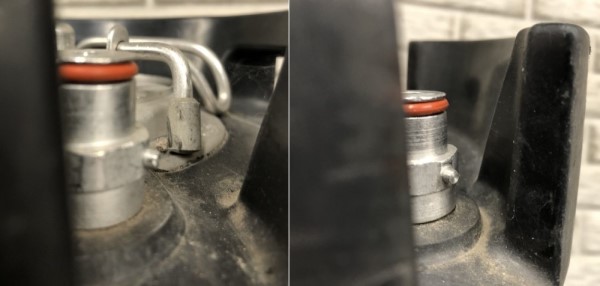 It may be difficult to see in these photos, but the left side shows a pin lock post with a ball lock o-ring installed on it. The right side shows a pin lock post with the pin lock o-ring installed on it. The pin lock o-ring extends out just a little bit further than the ball lock o-ring. The ball lock o-ring is nearly flush the the lip on the post. That small amount is the difference between the two o-rings.
It may be difficult to see in these photos, but the left side shows a pin lock post with a ball lock o-ring installed on it. The right side shows a pin lock post with the pin lock o-ring installed on it. The pin lock o-ring extends out just a little bit further than the ball lock o-ring. The ball lock o-ring is nearly flush the the lip on the post. That small amount is the difference between the two o-rings.
I recommend stocking up on food grade spare o-rings. This is especially true for post o-rings. I recommend you change those liberally. See: Why Won’t My Homebrew Carbonate? Fixing Beer Carbonation Problems – for more information on that.
Buying in bulk means you save money and you’ll have spares when you need them
Food Safe Replacement O-Rings – More Info
Related: What’s the Difference Between Ball Lock Kegs and Pin Lock Kegs
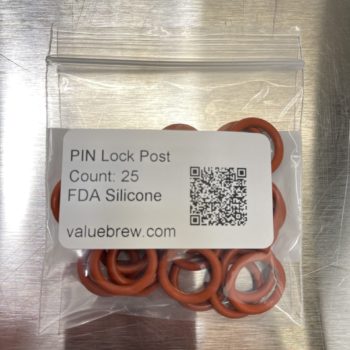 Via our Keg Rebuild Post – Jump To: Replacing O-Rings – Jump To: Pin Lock Section
Via our Keg Rebuild Post – Jump To: Replacing O-Rings – Jump To: Pin Lock Section
Universal Poppet O-Rings
Size Dash 008 fit all styles of Universal Poppet that I have tested. Since universal poppets can vary slightly between manufacturers, I cannot guarantee they will work with your poppet.
- Food Safe, Silicone – Universal Poppet Replacement O-Rings – Food Safe Silicone – *see note on food safety
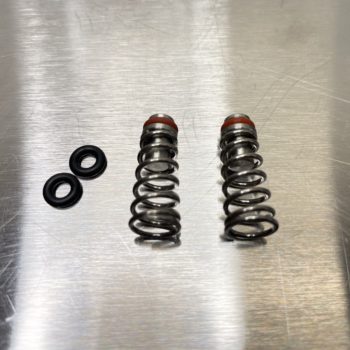 See: Installing and Adjusting Universal Poppets via our Keg Rebuild Post
See: Installing and Adjusting Universal Poppets via our Keg Rebuild Post
Universal Poppets – 304 Stainless + Food Grade Silicone! & Reliable O-Ring Replacements
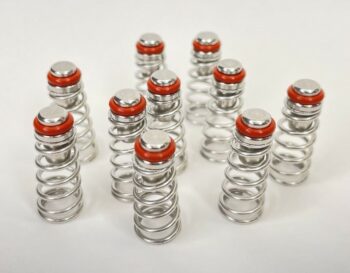 Valuebrew has released a 304 Stainless Steel + Food Grade Silicone Universal Poppet option!
Valuebrew has released a 304 Stainless Steel + Food Grade Silicone Universal Poppet option!
I’ve long advocated for tossing OEM o-rings. I’m excited that there’s finally there’s an option that comes with quality o-rings made from the right materials out of the box! Beyond that, Valuebrew has pledged to always carry replacement o-rings, so you’ll always have a source when the time comes for replacements.
Food Safe Materials for Keg O-Rings?
Most of the o-ring part numbers that are linked in this post are not specifically marketed for food use or as food safe.
In my experience, it’s extremely difficult to find offerings that claim to be safe for food contact. Maybe some of the o-rings that are available are food safe, but very few are actually labeled as such.
But why? One possible reason… they aren’t food safe. Beyond that, one industry insider I spoke with said suppliers have a potential problem with fulfillment. Since many options and materials are available, It’s difficult for some distributors or sellers to guarantee you’re getting a food safe option.
- Just because an o-ring is marketed for use in a keg doesn’t automatically mean that the materials and production processes used are food safe.
- If you think about it from a random supplier or manufacturer’s perspective… they don’t know what you’re putting in your keg, maybe it’s not even food. The problem that we, as homebrewers, have is is… beer is food and meant for human consumption.
- You cannot say all o-rings made from [fill in material here] are food safe. Certain quality standards and processes are required.
There are some food safe options. One notable supplier features all food safe o-ring offerings.
When I know that something is sold as food safe, I’ve labeled it as such in this reference.
Generally speaking, food safe o-rings may cost a little more, but, we’re, generally, only talking a few cents per o-ring. It’s worth it.
If you’re using your keg for anything food related… My recommendation is to purchase o-rings made out of material safe for food contact.
Check each product page for specifications and application recommendations. These can change. Contact manufacturers with questions about suitability for a particular application.
Shelf Life and When Should I Replace My Keg O-Rings?
Generally Speaking, I think you should replace all keg o-rings when you refurbish or obtain a used keg.
What about after that? Of course, you could just keep using them until they break, they smell or look horrible or… until you lose a tank of CO2 due to an o-ring related leak. On the other end of the spectrum some people change o-rings every time they keg.
Depending on material, keg o-rings have a shelf life. At some point, materials may become brittle. Beyond shelf life, o-rings wear out from use – compression and abrasion. The other potential issue is materials compatibility. Do your o-rings break down from the chemicals you subject them to?
Depending on material, keg o-rings have a shelf life. At some point, materials may become brittle. Beyond shelf life, o-rings wear out from use – compression and abrasion. The other potential issue is materials compatibility. Do your o-rings break down from the chemicals you subject them to?
Keg manufacturer AEB says to replace o-rings yearly. AEB produces some of the best kegs on the market and I agree with the one year in most cases. Because of their very low cost, I suggest changing high contact, high risk leak o-rings more often.
High Risk:
- Post o-rings: Especially gas. Leaks originating from gas post very difficult to detect.
- Gas dip tube o-rings: Leaks here are easier to detect, but I also classify these as high risk. A leak at either the gas post or gas dip tube is invisible and has frustrating consequences… heading to your CO2 source to swap or fill a tank. Better safe than sorry.
High Contact: Internal QD and Universal Poppet O-Rings. These touch every ounce of beer that’s poured.
I suggest using Daylight Savings dates as a reminder. Something like this…
- Daylight Savings Begins (Spring): Replace high leak risk and high contact o-rings – Post O-Rings (especially gas), Gas Dip Tube, Internal QD O-Rings and Universal Poppet O-Rings.
- Daylight Savings Time Ends (Fall): Replace all keg, poppet and QD o-rings.
Most of these o-rings are pennies each when bought in reasonable bulk quantities. Regularly replacing, costs very little and helps stave off unwanted off flavors, leaks and lost CO2. This schedule should keep your kegs working great from a gasket perspective.
The one gaskets that are a little more expensive are lid o-rings. If you wanted to get a little more life out of those, you could replace lid o-rings in odd years when Daylight Savings Time Ends (Fall). This would make them two years old when they’re replaced.
This section is part of my post on rebuilding kegs – Jump To This Section – If you look through the post you’ll see just how good the keg looks at the end.
One-Off and Metric Sized Keg O-Rings
I’ve heard very sporadic feedback that some kegs feature non-standard sizes. I’ve also heard that some kegs outside of North America use metric sizes.
Most kegs we use in the US are currently manufactured overseas. In spite of that, we’re seeing replacement parts continue to use standard sizes. Maybe there are some one-offs, but the vast majority of manufacturers are using the o-rings sizes outlined in this resource. That’s a good thing.
Dip tube o-rings seem to be the most likely to be non-standard.
I’ve never had theses problems myself, but I do believe it rarely happens. My suggestion is to compare sizes the first time you replace keg o-rings. If they look the same, they’re probably the same… I’d go for it. From there I would 1: Thoroughly check the keg for leaks and 2: Hang on to the old o-rings for a while. Discard the old o-rings when you’re sure standard o-rings fit.
Other Keg and Kegerator Rebuild & Replacement Parts
Most retailers feature a good selection of keg parts. These are some picks of individual offerings and sources based on each part type.
TIp: If you’re replacing lids on pin lock kegs, I suggest using ball lock style lids. Those generally include manual PRV valves that making venting your keg a whole lot easier. Standard ball lock style keg lids fit on standard pin lock kegs.
Replacement Lids
- New Cornelius Keg Lid with New pressure relief valve (lid o-ring included) via AIH – generally speaking, one of the best everyday values for replacement keg lids
- New Italian Lid for Cornelius or Firestone Kegs – via Keg Connection
- Keg Lid with Hang Tab – via Wiliam’s Brewing – this is a unique offering in that it features a hang tab on the underside of the lid to make hanging hop bags and such easy
- Used Pin lock Keg Lid – via Keg Connection
- Amazon can be a great source for keg lids. Offerings can come and go quickly. Search Amazon for “replacement keg lid” to see what’s available
Poppets
OEM specific poppets can be hard to track down because you need the specific model #. Beyond that they’re usually expensive. Because of that I recommend universal poppets.
- My Pick: Universal Poppets via Valuebrew – When these are in stock, they’re my pick because of 304 SS Construction + Food Grade Silicone and a reliable source for replacement o-rings. Valuebrew has committed to always carrying replacement for their universal poppets.
- If Valuebrew is out of stock… Search Amazon for “Universal Poppets” – look for quality stainless construction. I recommend immediately discarding included o-rings and replacing with a known food grade option that’s easy to source when it comes time for replacements.
Tip: I use universal-type poppets exclusively when rebuilding kegs. Tip: In my experience, universal poppets fit the vast majority of kegs without issue. I have had a couple kegs that ended up being a bit too tight with these. It’s an easy fix. Use a pair of wire cutters or Nipper Pliers to trim the universal poppet. I suggest taking off about half of a coil and testing. You want the QD to slide on easily and for it to reliably hold pressure when the QD is off. Taking off a half of a coil and testing helps you make sure you don’t end up making the poppet too loose.
Related: Universal Poppet Tips and Tricks
Keg Lid Pressure Relief PRV Valves
- Replacement Keg PRV Valves – via AIH
- Pressure Relief Valve Ring – via AIH
- Lid Pressure Relief Valve – via Keg Connection
- Pressure Relief Valve, Replacement Ring – via Keg Connection
- Search Amazon for “keg lid PRV valve” – check compatibility with your keg
Keg Posts
- Keg Outlet carries loads of post options
- Keg Connection has an extensive lineup of keg replacement parts including posts
- Offerings seem to come and go quickly. Search Amazon for “replacement keg posts” to shop around
- Threaded Ball Lock Posts – these NPT threaded ball lock posts allow you to add a ball lock post pretty much anywhere you want to – Liquid, Gas
Post Thread Sizes:
Keg Type Gas Post Size – Thread Liquid Post Size – Thread Product Link
- Cornelius Spartan 19/32″ – 18 19/32″ – 18
- Cornelius R (Pin Lock) 19/32″ – 18 (2 Pin) 19/32″ – 18 (3 Pin)
- Firestone A (Pin Lock) 9/16″ – 18 (2 Pin) 9/16″ – 18 (3 Pin)
- Firestone R (Pin Lock) 9/16″ – 18 (2 Pin) 9/16″ – 18 (3 Pin)
- Firestone Challenger 11/16″ – 18 3/4″ – 18
- Firestone Super Challenger 9/16″ – 18 5/8″ – 18
- Firestone V Challenger 9/16″ – 18 5/8″ – 18
- Firestone VI Challenger 9/16″ – 18 5/8″ – 18
- John Wood 85 11/16″ – 18 3/4″ – 18
- John Wood RA (Pin Lock) 9/16″ – 18 (2 Pin) 9/16″ – 18 (3 Pin)
- John Wood RC (Pin Lock) 9/16″ – 18 (2 Pin) 9/16″ – 18 (3 Pin)
- Super Champion 19/32″ – 18 19/32″ – 18
- AEB Kegs 19/32” – 18 19/32″ – 18
Thanks to Keg Outlet for this information. They carry many of these options.
Universal Keg Posts
These aren’t universal the same sense that universal poppets are universal. They are threaded to work with most ball lock kegs not all kegs in general. They are universal in that they work with both gas AND liquid QDs. Make sure your keg threads are compatible
- Universal Cornelius Posts – via William’s Brewing
- Universal Body Connect for Gas and Bev – Ball Lock KEG467 – via MoreBeer
Keg Lid Feet
Bad or missing keg lid feet can cause keg lids to seal improperly. They help the lid bails to contact the top of your keg and provide back pressure that seals up the lid enough to hold pressure when you apply CO2.
- Keg Lid Handle Cap – via AIH
- Grey Keg Clamp Foot – via William’s Brewing
- Corny Keg Lid Foot KEG442 – via MoreBeer
- Lid foot, Feet for Keg Lids, Cornelius and Firestone – via Keg Connection
- Foot for Keg Lids, Cornelius and Firestone Flat style – via Keg Connection
- Most homebrew shops sell singles, Amazon can be a source for buying packs of these – search Amazon for “keg lid feet” to shop around
Keg QD Replacement Parts
- Replacement Internal QD O-Rings – although these are not OEM, they’ve worked in every standard-type QD I’ve tried them in, they’re food grade and they can be had for cheap
- Ball Lock QD Repair Kit – via Adventures in Homebrewing
- CM Becker Brand Pin and Ball Lock Quick Disconnect Repair Parts – via Keg Connection
Replacement Dip Tubes
- Gas Dip Tube – via AIH
- Liquid Dip Tube – via MoreBeer – Straight – for Firestone and Cornelius
- Curved Liquid Dip Tube – via MoreBeer
- Amazon can also be a good source – search Amazon for keg dip tube to shop around
Floating Dip Tubes
Adding a floating dip tube can be a great upgrade
- Top Draw Beer Pick Up Tube – via William’s Brewing
- FLOTit 2.0 Floating Dip Tube
- Torpedo Keg Buoy ™ Floating Dip Tube KEG655 – Hands on Review
My Explanation of How Floating Dip Tubes Work:
When we carbonate a keg, pressure is being applied to the keg from the top, via the head space. Beer at the top carbonates first. That carbonation works it’s way down the keg. I’m sure there’s also some movement in the keg that helps to mix things up and distribute carbonation. But just sitting there, I think that mixing is a slow process. However it all works, practically speaking, the beer at the top carbonates more quickly compared to the beer at the bottom. This allows you to serve from the top accessing the more carbonated portion of the keg. It’s also a benefit for clarity because trub settles out heading downward. You can see this stratification in a glass carboy. As the beer starts to clear, the top clears first. I don’t think if this is exactly accurate, but I picture carbonation happening with the same sort of stratification until the beer reaches equilibrium and is equally carbonated throughout.
Faucet Repair Parts and Resources
- Seal Kits for Intertap Faucets
- Seal Kit for Intertap Flow Control Faucets
- Seal Kit for NukaTap Faucets
- MoreBeer’s Intertap Faucet Parts Kit
- Perlick 630SS Front Seat O-Ring Replacement
- Perlick 600 Series Diagram and Repair Parts
- Perlick 525 Rebuild Kit
- Perlick 525 Diagram and Repair Parts
- Standard Faucet Diagram and Repair Parts
- Stout Faucet Diagram and Repair Parts
Related Reviews:
- Hands on Review: Intertap Forward Sealing Faucets and Accessories
- Hands on Review: NukaTap Forward Sealing Beer Faucets
Replacement Keg Handles and Bases
To my knowledge, replacement handles and bases are not generally available. However, in a lot of cases, you can fix loose rubber handles and bases.
See: Fix It! Repairing Loose Cornelius Keg Handles and Bases
Keg Quick Disconnects
- Kegland Flow Control Ball Lock Liquid QDs – at William’s Brewing & MoreBeer – These ball lock QDs are made from stainless steel. Beyond that they also have a unique feature that allows you to change the resistance that the QD is exerting on your beer. That means you can dial in flow right at the QD. That allows you to make modifications for lower or higher carbonation levels without changing tubing lengths.
- Gas QD with Integrated Check Valve – Prevents Beer Back-Feeding – Ball Lock – Pin Lock – keep beer from flowing the wrong way
- Inline Check Valves – MFL, Barbed
- Low Profile Pin Lock QDs (5/8″ Shorter) – Liquid – Gas – Combo – these are great if you’re having clearance problems.
- This is another item that Amazon can have some good options – search “keg quick disconnect” to shop around
Kegland DuoTight QDs
An easy choice if you use the great DuoTight System
- Hands on Review: Kegland DuoTight Ball Lock QDs!
- KegLand Duotight 8mm Beer Ball Lock – via William’s Brewing
- KegLand Duotight 8mm Gas Ball Lock – via William’s Brewing
- Duotight Ball Lock Quick Disconnect (QD) Beverage Out – 8 mm DUO151 – via MoreBeer
- Duotight Ball Lock Quick Disconnect (QD) Gas In – 8 mm DUO150 – via MoreBeer
Stainless Steel Ball Lock Quick Disconnects
- Torpedo SS Ball Lock QDS at MoreBeer
- Adventures in Homebrewing offers a number of SS QD models – Keg Disconnects at AIH
Racetrack Style Keg Parts
Racetrack style kegs – standard kegs, both pin lock and ball lock are… standard. Some parts on those are interchangeable – dip tubes, o-rings, universal poppets. The big outlier are… racetrack style ball locks. These perform the exact same function but some of the parts are not what I would call standard – the lids are more oval and the dip tubes and other parts are different. As of this posting, Adventures in Homebrewing is the place to get hard to find racetrack keg parts. These used to be very hard to find. AIH has scooped up a lot of what was left and had other parts manufactured. – Search racetrack at AIH
Tools for Removing Keg Posts
- Keg Sockets – Choose Your Sockets – via Keg Connection – choose from ball lock and pin lock compatible sockets
- Search Amazon for “Pin Lock Socket”
- 11/16″ 6 point: CRAFTSMAN Deep Socket, SAE, 3/8-Inch Drive, 11/16-Inch, 6-Point (CMMT43336) – affiliate link, note that multiple variations of this product may be available, as such a different version may appear at this link
- 11/16″ 12 point: CRAFTSMAN Deep Socket, SAE, 1/2-Inch Drive, 11/16-Inch, 12-Point (CMMT47524) – affiliate link, note that multiple variations of this product may be available, as such a different version may appear at this link
- 7/8″ 12 point: CRAFTSMAN Deep Socket, SAE, 1/2-Inch Drive, 7/8-Inch, 12-Point (CMMT47528) – affiliate link, note that multiple variations of this product may be available, as such a different version may appear at this link
- Hands on Review: Craftsman Deep Well Sockets for Ball Lock Keg Posts
- Hands on Review: “Ball Lock Keg Wrench” – 11/16″+7/8″ Ratcheting Wrench – via Apollo Tools Wrench Set
Odds and Ends
- Stainless Steel Ball Lock Jumper with Food Grade Silicone O-Rings – Hands on Review : Allows you to connect multiple ball lock runs to clean multiple lines and taps at the same time. Works with both liquid and gas QDs. Stainless Steel Ball Lock Jumper – via Valuebrew – An easy add-on… food grade o-rings, featured in our Keg Rebuild Post
- Duotight Inline Regulator – allows you to control pressure on line by line basis – Use for portable serving!
- Pin Lock Keg Depressurizer Tool – These help you easily vent pin lock kegs – since pin lock style lids don’t have a PRV
Keg Parts Landing Pages
- Adventures in Homebrewing
- Keg Connection – huge selection of homebrew and commercial keg parts
- MoreBeer
- William’s Brewing
Reviews!
We’ve got loads of Draft and Kegerator related reviews! Check out the lineup…
Rebuild Your Kegs
DuoTights!
Kegland’s DuoTight Fittings are designed to work with EVABarrier Double Wall Tubing. They offer quick, reliable connections, easy implementation, a variety of fitting options and feature amazing versatility. They’re also, generally speaking, very well priced. DuoTights are push to connect fittings and require no tubing clamps.
As you’re considering repairing and replacing parts in your kegerator, I think DuoTights deserve a hard look
Our Curated List of Keg Deals!
Recent Deals!
10 Most Recent Homebrew Resource Posts & How-To’s!
We are Homebrew Review HQ! Our 10 Most Recent Reviews
Also: Kegerator Tips & Gear | Keg Repair Part #s | Recent Keg Finds
Our Top Draft Resources!
- The Most Difficult Spot to Check for CO2 Leaks
- Keg O-Ring Materials Selection! – EPDM, Silicone and Buna-N?
- Why Do I Have Bubbles in My Beer Line? Diagnosing and Fixing Kegerator Foam Problems
- Five Benefits of Using Corny Kegs As Fermenters
- Rebuilding & Reconditioning Homebrew Kegs!
- Food Safe Replacement Keg O-Rings in Bulk
- Hands on Review: Kegland DuoTight Fittings & EVABarrier Tubing!
- Why Won’t My Homebrew Keg Carbonate? Fixing Draft Beer Carbonation Problems
- What Does a Flow Control Faucet Do?
- Upgrade Your Kegerator – 6 Improvements!
- Serve Homebrew on Any Kegerator & Convert Commercial Kegerator to Homebrew
- Tips and Gear for Growler Filling
- What’s the Difference Between Ball Lock Kegs and Pin Lock Kegs?
- Checking for Draft System CO2 Leaks – Using The Pressure Gauge Method
- Tip: Consider Oetiker Stepless Clamps for Kegerator Gas and Beer Lines
- Hands On Review: Inkbird ITC-308 Dual Stage Temperature Controller +WiFi Version
- Universal Poppets Tips and Tricks!
- Convert Your Mark II Keg & Carboy Washer to a Recirculating Draft Line Cleaning Pump!
- Step by Step: Finding and Fixing Keg CO2 Leaks
- Kegerator Beer Line Temperatures & Reducing Foam with a Recirculating Fan
- Kegging CO2 Use Estimations and Calculations
- Step by Step: Balancing Your Kegerator Draft System
- Building a Simple Ball Lock Draft Line Flushing Setup
- Build a Recirculating Draft Line Cleaning Pump
- Home Brew Keg Roundup – New & Used, 5 and 2.5 Gallon & More!
- Damp Kegerator? Fix Kegerator Condensation
- Portable Draft Beer Serving Options!
- Homebrew Temp Controller Roundup! – Kegerator and Fermentation – concepts, applications and models
- Bulk Keg Orings and Keg Repair Part Numbers
This post may contain affiliate links. We may make a commission when you use our links. This will never cost you extra. Thank you for supporting Homebrew Finds!
Make sure the components you use are compatible and rated for your intended application. Contact manufacturer with questions about suitability or a specific application. Always read and follow manufacturer directions.tag:lnksfxd toppost:kegoringsandparts rs:7 tag:tpr
